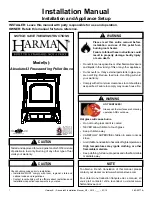
9
800.421.0771
Section 5: Additional Safety Precautions
1. Ash Disposal:
Ashes should be placed in a metal container with a tight fitting lid.
The closed container of ashes should be placed on a non-combustible floor or on
the ground, well away from combustible materials, pending final disposal. If the
ashes are disposed of by burial in sailor otherwise locally dispersed they should be
retained in the closed container until all cinders have thoroughly cooled.
2. Liquid Fuels:
Never use gasoline type lantern fuel, kerosene, charcoal lighter fluid,
or similar liquids to start or “freshen up” a fire in this heater. Keep all such liquids
well away from the heater while it is in use.
3. Creosote Formation & Removal:
When wood is burned slowly. it produces tar
and other organic vapors which combine with expelled moisture to form creosote.
The creosote vapors condense in the relatively cool chimney flue of a slow burning
fire. As a result, creosote residue accumulates on the flue lining. When ignited, this
creosote makes an extremely hot fire. CAUTION: Do not operate the stove to such
an extreme that any portion becomes “red hot”.
4. Pre-Fabricated Chimney:
Class A masonry or all fuel pre-fabricated chimneys
must be listed as approved by Underwriters Laboratories (UL) or you may use
“Metal vent” and “Metalbestos” for use as your chimney.
5. Inspection Codes:
The installation of the stove must comply with state and local
requirements and be inspected by the state or local building inspector, if required.
6. Location:
This stove is not approved or recommended for use in mobile homes.
Do not locate a wood burning stove in a bedroom or sleeping area. The stove
should be placed centrally in relationship to the area to be heated. High traffic
areas should be avoided, and the stove should be located in a relatively draft-free
area. A 24 inch clearance to furnishings must be maintained.
7. Regular Inspection:
Inspect chimney connector and chimney twice monthly and
clean if necessary.
Safety Notice:
If this wood stove is not properly installed, a house fire may result.
For your safety, follow the installation directions. Contact local building officials
about restrictions and installation inspection in your area.


































